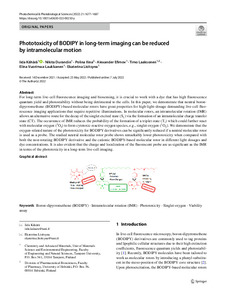Phototoxicity of BODIPY in long-term imaging can be reduced by intramolecular motion
Kähärä, Iida; Durandin, Nikita; Ilina, Polina; Efimov, Alexander; Laaksonen, Timo; Vuorimaa-Laukkanen, Elina; Lisitsyna, Ekaterina (2022-09)
Kähärä, Iida
Durandin, Nikita
Ilina, Polina
Efimov, Alexander
Laaksonen, Timo
Vuorimaa-Laukkanen, Elina
Lisitsyna, Ekaterina
09 / 2022
Julkaisun pysyvä osoite on
https://urn.fi/URN:NBN:fi:tuni-202210037392
https://urn.fi/URN:NBN:fi:tuni-202210037392
Kuvaus
Peer reviewed
Tiivistelmä
For long-term live-cell fluorescence imaging and biosensing, it is crucial to work with a dye that has high fluorescence quantum yield and photostability without being detrimental to the cells. In this paper, we demonstrate that neutral boron-dipyrromethene (BODIPY)-based molecular rotors have great properties for high-light-dosage demanding live-cell fluorescence imaging applications that require repetitive illuminations. In molecular rotors, an intramolecular rotation (IMR) allows an alternative route for the decay of the singlet excited state (S1) via the formation of an intramolecular charge transfer state (CT). The occurrence of IMR reduces the probability of the formation of a triplet state (T1) which could further react with molecular oxygen (3O2) to form cytotoxic reactive oxygen species, e.g., singlet oxygen (1O2). We demonstrate that the oxygen-related nature of the phototoxicity for BODIPY derivatives can be significantly reduced if a neutral molecular rotor is used as a probe. The studied neutral molecular rotor probe shows remarkably lower phototoxicity when compared with both the non-rotating BODIPY derivative and the cationic BODIPY-based molecular rotor in different light dosages and dye concentrations. It is also evident that the charge and localization of the fluorescent probe are as significant as the IMR in terms of the phototoxicity in a long-term live-cell imaging. Graphical abstract: [Figure not available: see fulltext.].
Kokoelmat
- TUNICRIS-julkaisut [16929]
